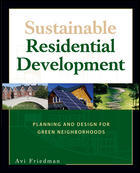December 21, 2007 Categories: Reviews
Sustainable Residential Development: Planning and Design for Green Neighborhoods
Avi Friedman, McGill University
2007. McGraw-Hill. 288 pp. $59.95.

“The thrust of this book is to reintroduce common sense to the design of neighborhoods,” writes the author in his preface. {xi} To the usual lingo of sustainability he adds the concept that decision-makers should follow “the path of least negative impact…a path that will result in the smallest negative impact on the environmental, societal, and economic factors of a project.” {10} He discusses infill, grayfield (commercial), and greenfield sites. Infill, while preferable in his eyes, can be difficult to build: “When an entire area or a single plot of land has remained vacant, there is usually a good reason for it”—environmental, political, technical, or legal. {48}
Sure enough, most of the projects Friedman describes in detail are greenfield projects, such as La Foret de Marie-Victorin near Saint-Nicolas, Quebec. His description of the planning process there suggests a purely professional reason why infill projects sometimes don’t get done, and don’t get the publicity when they are done: they don’t give the architect/planner/developer as much scope. At La Foret, “we started…by studying regional and urban issues and their potential effect on the site. We correlated the contribution of these aspects to sustainability…. We began a careful study of the site´s natural assets,” including “existing microclimates. …Identifying the site’s flora and fauna was the next stage.” {73} The one infill project discussed – in Le Village, a neighborhood of Cornwall, Ontario – also involved careful study of the neighborhood and involvement of residents, but it simply couldn’t offer the same chance to start fresh and do it right. Indeed, the architectural guidelines for maintaining the neighborhood´s character are meticulous (“sliding doors are not permitted”). {234}
Friedman describes his case studies in generous detail. Interestingly for a book that extols density, each of the three rehabilitated Le Village houses discussed in detail was converted from a duplex to single-family occupancy. {234-6} It is hard to swim against the current.
—Harold Henderson
Henderson, the CBC’s communications consultant, has reviewed books for the American Planning Association’s magazine Planning for 20 years. From 1985 to 2007 he was a staff writer at the weekly Chicago Reader, covering many topics, including environmental and planning issues. The opinions expressed in these reviews are his and not necessarily those of the University of Notre Dame or its School of Architecture.
